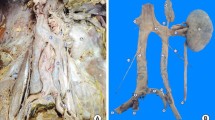Abstract
Absence of the superior vena cava (SVC) is a rare variety of vascular anomaly. The purpose of this report is to describe the computed tomography (CT) findings of the partial absence of the SVC without persistent left SVC in a patient with no evidence of congenital cardiovascular disease and no prior history of central venous instrumentation. A 77-year-old woman with a history of colon cancer underwent thoracoabdominal CT imaging because of abdominal pain of uncertain cause. No tumor recurrence was observed. A complicated“investigation” confirmed a thymoid cancer surgery back in 1976, which was accompanied by resection of the SVC and the left brachiocephalic vein because of their invasion. Owing to the absence of the SVC and bilateral brachiocephalic veins, caval hypertension developed in the patient, resulting in the dilation of cavo-caval anastomoses. In addition, new anastomoses were opened. The clinical significance and possible embryogenesis of this anomaly are discussed. The extremely rare condition of the partial absence of the SVC appeared with subcutaneous dilated, tortuous collaterals in an asymptomatic adult patient. This anomaly is becoming clinically more relevant with the increasing use of minimally invasive vascular surgery.
Zusammenfassung
Das Fehlen der V. cava superior (VCS) ist eine seltene Variation der Gefäßanomalien, die mit zunehmender Anwendung minimal-invasiver interventioneller radiologischer und chirurgischer Verfahren an den Gefäßen eine wichtige klinische Rolle spielt. Zweck dieses Beitrags ist es, die Befunde der Computertomographie (CT) bei teilweise fehlender VCS ohne persistierende linke VCS bei einer Patientin ohne Hinweis auf angeborene kardiovaskuläre Erkrankungen und ohne Vorgeschichte einer zentralvenösen Instrumentierung zu beschreiben. Bei einer 77-jährigen Frau mit Kolonkarzinom in der Anamnese erfolgte eine thorakoabdominale CT aufgrund unklarer Unterleibsschmerzen. Diese traten nicht wieder auf. Eine komplizierte „Nachforschung“ erbrachte den Nachweis einer Operation wegen eines Thymuskarzinoms 1976 mit Resektion der SVC und der linken V. brachiocephalica aufgrund von Tumorinvasion. Wegen des Fehlens der VCS und der V. brachiocephalica beidseits entwickelte sich eine kavale Hypertonie, die in der Ausdehnung kavokavaler Anastomosen resultierte. Außerdem öffneten sich neue Anastomosen. Klinische Bedeutung und mögliche Embryogenese dieser Anomalie werden besprochen. Das äußerst seltene teilweise Fehlen der VCS scheint mit subkutan ausgedehnten, gewundenen Kollateralen bei einem asymptomatischen erwachsenen Patienten einherzugehen. Diese Anomalie wird klinisch relevanter mit der zunehmenden Anwendung minimal-invasiver chirurgischer Verfahren an den Gefäßen.






Similar content being viewed by others
References
Krasemann T, Kehl G, Vogt J, Asfour B (2003) Unusual systemic venous return with complete absence of the superior caval veins. Pediatr Cardiol 24:397–379
Bartram U, Van Praagh S, Levine JC et al (1997) Absent right superior vena cava in visceroatrial situs solitus. Am J Cardiol 80:175–183
Davis D, Pritchett EL, Klein GJ et al (1981) Persistant left superior vena cava in patients with congenital atrioventricular preexcitation conduction abnormalities. Am Heart J 101:677–679
Gray SW, Skandalakis JE (1972) Embryology for Surgeons. Saunders, Philadephia
Cha EM, Khoury GH (1972) Persistent Left superior vena cava. Radiologic and clinical significance. Radiology 103:375–381
Vasquez-Perez J, Frontera-Izquierdo P (1979) Anomalous drainage of the right superior vena cava into the left atrium as an isolated anomaly. Rare case report. Am Heart J 97:89–91
Braudo M, Beanlands DS, Trusler G (1968) Anomalous drainage of the right superior vena cava into the left atrium. Can Med Associ J 99:715–719
Park HY, Summerer MH, Preuss K et al (1983) Anomalous drainage of the right superior vena cava into the left atrium. J Am Coll Cardiol 2:358–362
Freedom RM, Schaffer MS, Rowe RD (1982) Anomalous low insertion of right superior vena cava. Br Heart J 48:601–603
Vydt T, Cools F, Rademakers FE (2003) Absent right and persistent left superior vena cava. Acta Cardiol 58:421–423
Colvin EV (1998) Cardiac embryology. In: Garson Jr A, Bricker DJ, Fisher DJ, Neish SR (eds) The science and practice of pediatric cardiology. 2nd ed. Williams & Wilkins, S 117–122
Barbaix E, Kerckaert I, D’herde K et al (2003) Simultaneous occurrence of a thyromediastinal muscle, a truncus bicaroticobrachialis, and a left superior vena cava. Clin Anat 16:176–181
Almeida FA, Pedra CA, Jesus CA de et al (1998) Coronary sinus atrial septal defect, ventricular septal defect and absence of left superior vena cava. Arq Bras Cardiol 71:613–617
Yanagihara K, Ueno Y, Kobayashi T et al (1997) Coronary artery fistula into a persistent left superior vena cava: report of a case. Surg Today 27:966–968
Snellen HA, Ingen HC van, Hoefsmit EC (1968) Patterns of anomalous pulmonary venous drainage. Circulation 38:45–63
Ichikawa T, Sekiguchi T, Kawada S et al (2012) Study of the association between an anomalous superior vena cava and horseshoe kidney. Circ J 76:1253–1258
Cormier MG, Yedlicka JW, Gray RJ, Moncada R (1989) Congenital anomalies of the superior vena cava: a CT study. Semin Roentgenol 24:77–83
Quinn RD, Myers JL, Pae WE Jr et al (1992) Orthotopic heart transplantation with preoperative unsuspected left superior vena cava and absence of right superior vena cava. J Heart Lung Transplant 11:147–151
Okreglicki AM, Millar RN (1998) VDD pacing in persistent left superior vena cava. Pacing Clin Electrophysiol 21:1189–1191
Acknowledgments
The timely help of Péter Kovács in finding the 1976 hospital record is greatly acknowledged.
Conflict of interest
On behalf of all authors, the corresponding author states that there are no conflicts of interest.
Author information
Authors and Affiliations
Corresponding author
Rights and permissions
About this article
Cite this article
Tarnoki, D., Tarnoki, A., Nemeth, K. et al. Partial absence of superior vena cava in an adult patient. Herz 38, 785–789 (2013). https://doi.org/10.1007/s00059-012-3747-1
Published:
Issue Date:
DOI: https://doi.org/10.1007/s00059-012-3747-1




